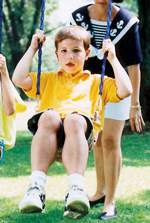Duchenne Muscular Dystrophy (DMD)
Signs and Symptoms
Progressive muscle weakness
 In Duchenne muscular dystrophy (DMD), muscle weakness selectively affects proximal muscles (close to the trunk) before distal (away from the trunk) muscles, and the legs before the arms. Additionally, boys with DMD often exhibit slower growth compared to unaffected boys, leading to shorter stature. Delayed walking is also a common early sign in affected boys.
In Duchenne muscular dystrophy (DMD), muscle weakness selectively affects proximal muscles (close to the trunk) before distal (away from the trunk) muscles, and the legs before the arms. Additionally, boys with DMD often exhibit slower growth compared to unaffected boys, leading to shorter stature. Delayed walking is also a common early sign in affected boys.
In toddlers, parents may notice enlarged calf muscles (see image at right). This false-enlargement is known as pseudohypertrophy because the muscle tissue becomes enlarged due to fat or other tissue buildup, but is actually weaker than regular muscle. Pseudohypertrophy can also occur in the muscles of the thighs.
A preschooler with DMD may seem clumsy and fall often. Parents also may note that affected boys have trouble climbing stairs, getting up from the floor, or running. When arising from the floor, affected boys may use hand support to push themselves to an upright position, also known as the “Gowers’ sign,” reflecting early weakness in the hip and thigh muscles. By school age, affected boys may walk on their toes or the balls of their feet with a slightly waddling gait and fall frequently. To try to keep their balance, they may stick out their bellies and pull back their shoulders. Children with DMD may also have difficulty raising their arms.
Many boys with DMD begin using an ambulatory assistive device such as a wheelchair by the early teenage years. Transition to a wheelchair is usually a gradual process; first, the chair may be required only to conserve the child's energy when covering long distances. Children with DMD often experience renewed independence once they fully transition to a power wheelchair. With the support of a power wheelchair, many regain mobility and autonomy in performing activities of daily living. In adolescence, weakness of the upper limbs, neck, and trunk becomes more limiting, and activities of daily living may require adaptive support or assistance. Boys and men with DMD often die in their late teens or 20s from respiratory insufficiency or cardiomyopathy; only a small percentage survive beyond the third decade.
Pain and sensation
Importantly, the muscle deterioration in DMD is not typically painful, though some individuals may experience muscle cramps or discomfort related to posture, scoliosis, or prolonged immobility. Because muscular dystrophy does not affect nerves directly, touch and other senses are normal, as is control over the smooth, or involuntary, muscles of the bladder and bowel, and sexual functions.
The heart
Cardiac involvement is inevitable in DMD, as the absence of dystrophin weakens the muscles of the heart (myocardium). This results in a condition called cardiomyopathy, which is characterized by fibrosis and scarring of the heart. DMD also can cause conduction abnormalities in the heart. Nearly all affected individuals older than 18 years present symptoms of cardiomyopathy. Over time, children and young adults may develop fatigue, shortness of breath, or palpitations due to declining cardiac function or conduction system abnormalities. Sometimes as early as the teen years, the damage done by DMD to the heart can become life-threatening. Cardiac function must be monitored closely, typically with annual echocardiograms or cardiac MRI, and cardioprotective therapy is recommended even in the absence of overt symptoms. See Medical Management for more on cardiomyopathy in DMD.
Respiratory function
Respiratory muscle weakness is also progressive. Serial monitoring of breathing capacity should start at the age of 5 or 6. The diaphragm and other muscles that support the lungs may weaken, making the lungs less effective at moving air in and out. Although an affected child may not complain of shortness of breath, problems that indicate poor respiratory function include headaches, mental dullness, difficulty concentrating or staying awake, and nightmares. Wheelchair-bound children tend to have evidence of poor pulmonary function.
Weakened respiratory muscles make coughing difficult, leading to increased risk of serious respiratory infection. A weakened cough increases susceptibility to respiratory infections, and a simple cold can progress to pneumonia. Preventive care, including influenza vaccination and airway clearance techniques, becomes essential. Noninvasive ventilation may be introduced during sleep as respiratory insufficiency progresses. See Medical Management for more on respiratory care in DMD.
Learning
Cognitive and behavioral challenges are common but variable. Approximately one-third of boys with DMD have some degree of learning disability, though significant intellectual disability is uncommon. Doctors believe that dystrophin abnormalities in the brain may have effects on cognition and behavior. Affected areas often include attention regulation, verbal memory, and emotional interaction. There is an increased prevalence of attention-deficit/hyperactivity disorder (ADHD), autism spectrum disorder, anxiety, and mood disorders.
Children suspected of having a learning disability can be evaluated by a developmental or pediatric neuropsychologist through the school system’s special education department or with a referral from their care team. Early evaluation by developmental or pediatric neuropsychologists can guide individualized education plans (IEPs) and behavioral interventions. Prompt support may improve school performance and emotional well-being. See Medical Management for more about learning disabilities in DMD.
Additional reading
- Birnkrant DJ, et al.; DMD Care Considerations Working Group. Diagnosis and management of Duchenne muscular dystrophy, part 1: diagnosis, and neuromuscular, rehabilitation, endocrine, and gastrointestinal and nutritional management. Lancet Neurol. 2018 Mar;17(3):251-267. doi: 10.1016/S1474-4422(18)30024-3. Epub 2018 Feb 3. Erratum in: Lancet Neurol. 2018 Jun;17(6):495. doi: 10.1016/S1474-4422(18)30125-X. PMID: 29395989; PMCID: PMC5869704.
- Birnkrant DJ, et al.; DMD Care Considerations Working Group. Diagnosis and management of Duchenne muscular dystrophy, part 2: respiratory, cardiac, bone health, and orthopaedic management. Lancet Neurol. 2018 Apr;17(4):347-361. doi: 10.1016/S1474-4422(18)30025-5. Epub 2018 Feb 3. PMID: 29395990; PMCID: PMC5889091.
- Birnkrant DJ, et al.; DMD Care Considerations Working Group. Diagnosis and management of Duchenne muscular dystrophy, part 3: primary care, emergency management, psychosocial care, and transitions of care across the lifespan. Lancet Neurol. 2018 May;17(5):445-455. doi: 10.1016/S1474-4422(18)30026-7. Epub 2018 Feb 2. PMID: 29398641; PMCID: PMC5902408.
Last reviewed May 2025 by Stephen Chrzanowski M.D., Ph.D.

